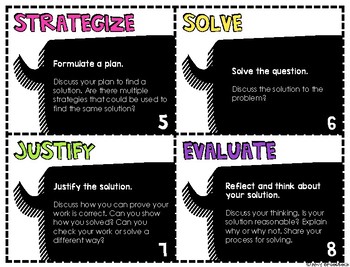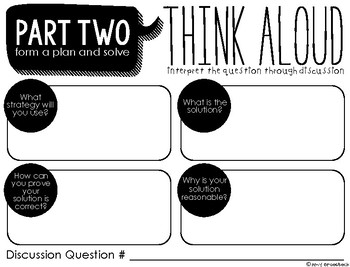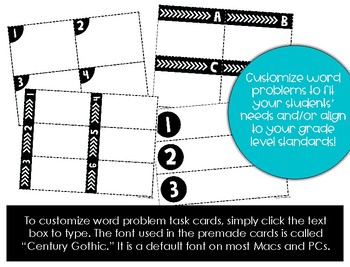What's the Operation - Determine When to Add, Subtract, Multiply, and Divide
Amy Groesbeck
42k Followers
Grade Levels
2nd - 5th
Subjects
Resource Type
Formats Included
- Zip
Pages
62 pages
Amy Groesbeck
42k Followers
What educators are saying
Used this activity with my students to review concepts prior to state testing. Students really enjoyed and were engaged! Thanks!
I was able to use this resource during small groups to help students differentiate between math operations.
Description
This word problem activity pack is designed to help develop your young mathematicians’ mathematical processes in order to demonstrate understanding of various operations in problem-solving scenarios.
PLEASE READ THE DESCRIPTION AND CHECK OUT THE PREVIEW TO SEE WHAT'S INCLUDED!
This set includes 5 activities to help supplement instruction when teaching students how to identify the correct math operation. Tasks include think aloud discussion cards, an operation sorting activity, task card hunt/scoot, and problem solving task card activity. Each activity includes identifying when to add or subtract, multiply or divide, or all four combined. BLANK/EDITABLE TASK CARD TEMPLATES ARE INCLUDED SO WORD PROBLEMS CAN BE CUSTOMIZED TO FIT YOUR STUDENTS’ NEEDS IN ANY GRADE LEVEL. PLEASE NOTE THAT PREMADE TASK CARDS ARE ALIGNED TO THIRD GRADE STANDARDS.
Each activity uses a combination of strategies to assist students’ thinking, which include:
ANALYZE:
1. Analyzing the questions being asked, write an answer statement
2. Determining what important information is needed to solve (what information is stated and not stated)
3. Identifying certain words that are commonly associated with mathematical operations
4. Determining if a total quantity is known or unknown
STRATEGIZE:
5. Form a plan to solve (choose a strategy to find solutions)
SOLVE:
6. Demonstrate the process for solving
JUSTIFY:
7. Demonstrate how the solution was found and/or check work with a different strategy
REFLECT:
8. Explain why the solution is reasonable
Activity 1 – Think and Write:
This activity is segmented into two parts. Parts one and two are designed to be completed separately, ideally within the same lesson.
Part One:
Pre-make four operation posters – addition, subtraction, multiplication, and division. In large letters, write the operation at the top of the poster, leaving the bottom portion open for students to record notes. Students will transition around the room and visit each math operation poster. At each poster, students will write facts they know about the operation, such as definitions, common vocabulary words, clue words, strategies, rules, or other helpful ideas.
Part Two:
As a class, discuss student responses on each operation poster to check for understanding or clear any possible misconceptions. Ask students to justify their responses and prompt them to share if they agree or disagree with other responses on the poster. Invite students to share what ideas are most important and record them on one large anchor chart.
Activity 2 - Think Aloud and Discuss Cards:
This activity is segmented into two parts. Parts one and two are designed to be completed separately, either in one class period or over two days.
Part One:
Students will analyze and discuss word problems with a partner or small group using think aloud discussion cards 1-4. Through discussion, students will identify: the question they are asked to solve, important information that is stated or not stated, and clue words that can help determine an appropriate operation. A recording sheet is included so students can record their thinking.
Part Two:
Students will review their responses from the discussion in part one. Using cards 5-8, students will form a plan to solve the problem, justify, and reflect on their work. A recording sheet is included so student can demonstrate their work and record their thoughts.
Activity 3 - Operation Sort:
This activity is segmented into two parts. Parts one and two are designed to be completed separately, either in one class period or over two days.
Part One:
Students will work with a partner or small group. Students will read each task card and answer the guiding questions (analyze) on the recording sheet labeled “Part One.” Students will identify the correct operation to solve and place the task card under the corresponding header card.
Part Two:
Students will review the work previously completed during part one. Students will reread each questions and develop a plan to solve (strategize). After demonstrating their work and finding a solution (solve), students will check their work for reasonableness (justify and reflect).
Activity 4 - Operation Hunt:
This activity is segmented into two parts. Parts one and two are designed to be completed separately, either in one class period or over two days.
Part One:
Students will hunt the classroom to locate task cards.
Students will read each task card and answer the guiding questions (analyze) on the recording sheet labeled “Part One.” Based on the information, students will record the appropriate operation.
Part Two:
Students will review the work previously completed during part one. Students will reread each question and develop a plan to solve (strategize). After demonstrating their work and finding a solution (solve), students will check their work for reasonableness (justify and reflect).
Activity 5 -What’s the Operation:
Students will identify the appropriate operation and find solutions to a variety of word problems using the following problem solving strategies:
1. What is the problem asking you to solve?
2. What important information is needed to solve?
3. What key words are stated?
4. Choose a strategy to demonstrate your process for solving
5. Justify your solution – show your work and check it
6. Reflect and think if your solution is reasonable
BONUS activity – Sounds Like a Plan (Graphic Organizer)
This graphic organizer can be used to supplement any of the activities in order to help students process information more efficiently and concisely. It can be used with the premade task cards or with any other word problem.
The organizer can also be used:
• During the start of the unit to model how the problem solving process should be carried out
• In small group to dig deeper into one or two problems
• In stations so students are able to demonstrate their independent analytical thinking
• To reteach students in need of additional problem solving practice
Happy teaching!
Amy
PLEASE READ THE DESCRIPTION AND CHECK OUT THE PREVIEW TO SEE WHAT'S INCLUDED!
This set includes 5 activities to help supplement instruction when teaching students how to identify the correct math operation. Tasks include think aloud discussion cards, an operation sorting activity, task card hunt/scoot, and problem solving task card activity. Each activity includes identifying when to add or subtract, multiply or divide, or all four combined. BLANK/EDITABLE TASK CARD TEMPLATES ARE INCLUDED SO WORD PROBLEMS CAN BE CUSTOMIZED TO FIT YOUR STUDENTS’ NEEDS IN ANY GRADE LEVEL. PLEASE NOTE THAT PREMADE TASK CARDS ARE ALIGNED TO THIRD GRADE STANDARDS.
Each activity uses a combination of strategies to assist students’ thinking, which include:
ANALYZE:
1. Analyzing the questions being asked, write an answer statement
2. Determining what important information is needed to solve (what information is stated and not stated)
3. Identifying certain words that are commonly associated with mathematical operations
4. Determining if a total quantity is known or unknown
STRATEGIZE:
5. Form a plan to solve (choose a strategy to find solutions)
SOLVE:
6. Demonstrate the process for solving
JUSTIFY:
7. Demonstrate how the solution was found and/or check work with a different strategy
REFLECT:
8. Explain why the solution is reasonable
Activity 1 – Think and Write:
This activity is segmented into two parts. Parts one and two are designed to be completed separately, ideally within the same lesson.
Part One:
Pre-make four operation posters – addition, subtraction, multiplication, and division. In large letters, write the operation at the top of the poster, leaving the bottom portion open for students to record notes. Students will transition around the room and visit each math operation poster. At each poster, students will write facts they know about the operation, such as definitions, common vocabulary words, clue words, strategies, rules, or other helpful ideas.
Part Two:
As a class, discuss student responses on each operation poster to check for understanding or clear any possible misconceptions. Ask students to justify their responses and prompt them to share if they agree or disagree with other responses on the poster. Invite students to share what ideas are most important and record them on one large anchor chart.
Activity 2 - Think Aloud and Discuss Cards:
This activity is segmented into two parts. Parts one and two are designed to be completed separately, either in one class period or over two days.
Part One:
Students will analyze and discuss word problems with a partner or small group using think aloud discussion cards 1-4. Through discussion, students will identify: the question they are asked to solve, important information that is stated or not stated, and clue words that can help determine an appropriate operation. A recording sheet is included so students can record their thinking.
Part Two:
Students will review their responses from the discussion in part one. Using cards 5-8, students will form a plan to solve the problem, justify, and reflect on their work. A recording sheet is included so student can demonstrate their work and record their thoughts.
Activity 3 - Operation Sort:
This activity is segmented into two parts. Parts one and two are designed to be completed separately, either in one class period or over two days.
Part One:
Students will work with a partner or small group. Students will read each task card and answer the guiding questions (analyze) on the recording sheet labeled “Part One.” Students will identify the correct operation to solve and place the task card under the corresponding header card.
Part Two:
Students will review the work previously completed during part one. Students will reread each questions and develop a plan to solve (strategize). After demonstrating their work and finding a solution (solve), students will check their work for reasonableness (justify and reflect).
Activity 4 - Operation Hunt:
This activity is segmented into two parts. Parts one and two are designed to be completed separately, either in one class period or over two days.
Part One:
Students will hunt the classroom to locate task cards.
Students will read each task card and answer the guiding questions (analyze) on the recording sheet labeled “Part One.” Based on the information, students will record the appropriate operation.
Part Two:
Students will review the work previously completed during part one. Students will reread each question and develop a plan to solve (strategize). After demonstrating their work and finding a solution (solve), students will check their work for reasonableness (justify and reflect).
Activity 5 -What’s the Operation:
Students will identify the appropriate operation and find solutions to a variety of word problems using the following problem solving strategies:
1. What is the problem asking you to solve?
2. What important information is needed to solve?
3. What key words are stated?
4. Choose a strategy to demonstrate your process for solving
5. Justify your solution – show your work and check it
6. Reflect and think if your solution is reasonable
BONUS activity – Sounds Like a Plan (Graphic Organizer)
This graphic organizer can be used to supplement any of the activities in order to help students process information more efficiently and concisely. It can be used with the premade task cards or with any other word problem.
The organizer can also be used:
• During the start of the unit to model how the problem solving process should be carried out
• In small group to dig deeper into one or two problems
• In stations so students are able to demonstrate their independent analytical thinking
• To reteach students in need of additional problem solving practice
Happy teaching!
Amy
Total Pages
62 pages
Answer Key
N/A
Teaching Duration
N/A
Report this resource to TPT
Reported resources will be reviewed by our team. Report this resource to let us know if this resource violates TPT’s content guidelines.





